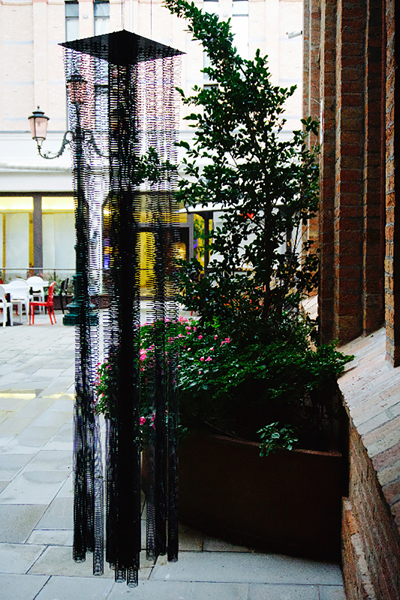
Piero Fogliati
Italia • Italy
Piero Fogliati begins with scenographic painting, then turns to innovative sculpture, rich in unexpected sounds and noises. In the centre of his work there is the dynamic ideal of the Fantastic City: he thinks of transforming the repetitive, chaotic town planning of our cities, stereotyped and cumbersome, enriching them with his art works which have not only aesthetic, but also spiritual purposes. By dialoguing with them through images and sounds, sensitive inhabitants can rediscover their own authentic interior being, in harmony with their most secret self.
Here in Venice - along the itineraries of the exhibition-event OPEN 18 - we can try out the idea ourselves with the Fleximofono (1967), a sculpture in silicon steel (spring steel). It dialogues visually with us through the springs of which it is made, but also through sounds and noises. Its “metal curls”, touched by the wind, begin to move and produce unexpected and fascinating sound effects.
Then the Fantastic City begins to use atmospheric phenomena too as “noble materials”. Water, wind, sunlight, colour and sound become the primary elements that suggest a spiritual life to the Cities renewed by Art. Fogliati adopts complex technologies and lakes and rivers are provided with sounds; raindrops are animated with colours, while Fogliati also prepares machines for decorating the skies. With time his relationship with the natural phenomena of Light and its various ways of being reflected, as well as with Sound and colours, is enriched with new discoveries linked to the increasingly more profound use of new technologies. Fogliati is entranced by the fact that colours - which had been the leitmotif of his early days as a painter, in the form of pigments - can now assume much more extraordinary luminous variety, thanks to the use of electricity. Now, these apparitions with their splendid colours are not only fictitious because they can disappear when you switch off the light, but they can also gladden us when they reappear. And that is the way they are supposed to be, or so the artist seems to suggest, because life is a game that each one of us can reinvent to suit our own image and likeness, especially if we do it one connected to the other, dialoguing and rediscovering ourselves through Art.
Daniela Palazzoli, Curator
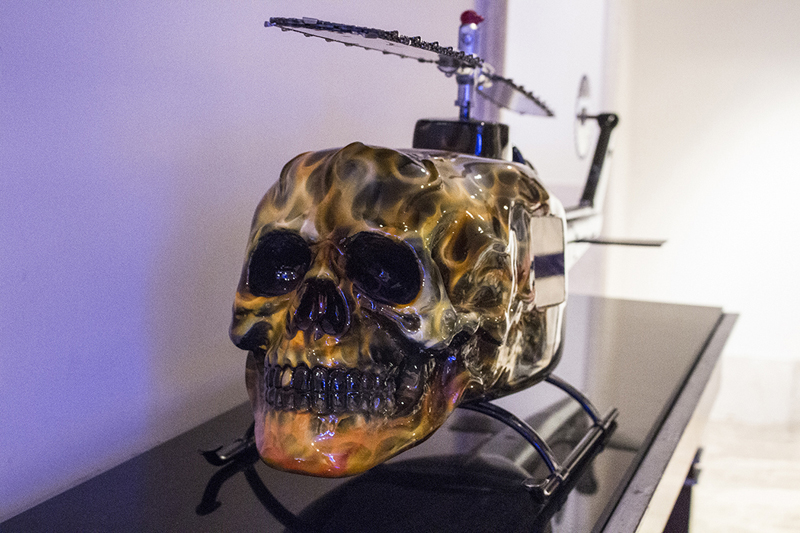
Francesco De Molfetta
Italia • Italy
Name: Demo Surname: still to be decided Profession: bomb disposal expert Age: apparently young enough to be considered a promising talent, but perhaps older since he is already being talked about all over the world Residence: in Alice’s Wonderland Pipe dream: selling toys
Short and irreverent curriculum: he began his studies with the masters of the Eighties and, like a mischievous student, though with an above- average IQ, he mocked his teachers and headmasters. He reworked the lessons taught in that period, distorting myths, status symbols, truthful heroes and comic strips, politicians, and all that is venerated by rest of the herd. As often happens in the best classes, his “nerdy” classmates were lost by the wayside; he has a satchel full of black marks on the class register, but also notes from the best art critics in Italy and the world.
His works in Plasticine become sculptures in resin and various materials, and go all over the world. He was so determined that he defeated Batman, who retired to a slimmers’ clinic, secretly consoling himself with a Nutella ice cream (or maybe some kind of surrogate...); he deposits dud cheques with lots of zeroes at the end, drawn on the Bank of Toyland, he freezes wedding cakes and understands that Michelangelo’s true vocation was to open a mechanic’s workshop. The paparazzi say that he has been seen around recently with Pinocchio...
We investigated to learn more about him... we kept receiving only excellent criticism, invitations to exhibitions in big famous galleries, even to the Permanente Museum in Milan... and now to OPEN 18 in Venice... So this Francesco De Molfetta must be really good... we are not afraid to call him by his real name, because we know he is a True Artist of this century, a time when there are unfortunately very few certainties.
Georges Braque said that “Art is made to disturb, science reassures”. I prefer to believe the opposite and I trust in art for a little carefreeness and to remember that in life we have to be able to laugh. I believe Demo thinks the same way.
Serena Mormino, Curator
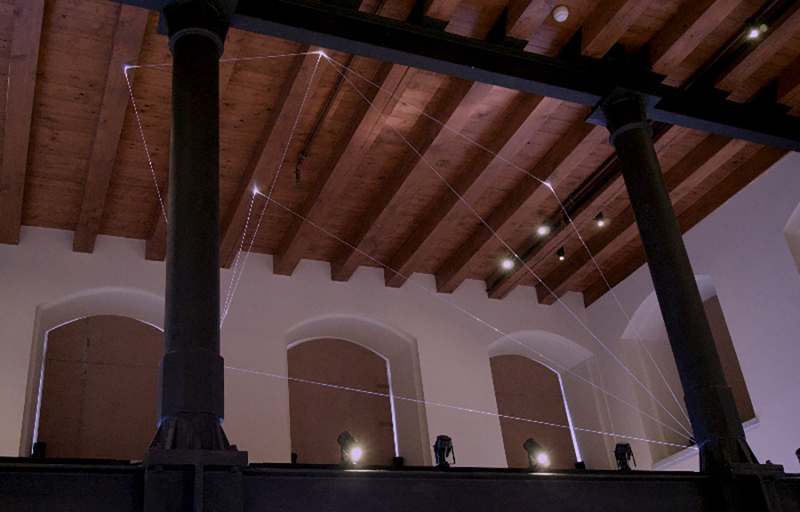
Carlo Bernardini
Italia • Italy
The artist starts out from fairly complex theoretical and methodological considerations and, taking his position in the field of sculpture, immediately raises the question of light and shade and their ability to occupy space. I am not referring to the body of the work, its pondus, but rather to light and shade as the two extremes of a dialectic where the middle term is not considered. Observing his sculptures we can in fact register the point of arrival of a language that reduces to the very limit of sculptural presence: filiform structures in steel, glowing screens, transparent slabs of Plexiglas - the least that can be said is that empty spaces predominate over solids to the point of virtually annihilating them...
In most cases, the optic fibres alone take over the space: the work lives entirely on the relationship between the luminous line, design in light, perfectly geometrical and so self–evident in its constructive links, and the space housing it. In this reciprocal relationship, space becomes a condition for the visibility of light and vice versa, the design in light is configured according to the structural characteristics of the space (which may contain objects that interact with the rays of light), space being charged with straight, powerfully energetic lines crossing it ceaselessly to trace out virtual volumes. All this, as we have seen, is “dematerialised”: light and shade, empty space, scant materials able to thin out almost to the point of eluding perception. Yet Bernardini is never too Hegelian: sight as a threshold opening on pure thought falls short of axiomatic triumph.
The body is topicalised with the same force in Bernardini’s work, yet it does not belong to the work. The role of physicality is delegated to the spectator, it is his/her body the work calls upon as the element that completes it, or rather founds it upon the sense relations it activates with space - space that is not conceived as abstract but in phenomenological terms, it is environment, lived space. The spectator’s body has not only the role of moving and perceiving, but also, with its movements, of transforming the work which changes appearance according to the point of observation. Like Paul Klee, Bernardini can say that his work postulates a drifting viewpoint, moved by the observer who, by moving to observe, modifies the work in its most essential aspect, its significant relationships with the environment.
Giorgio Verzotti
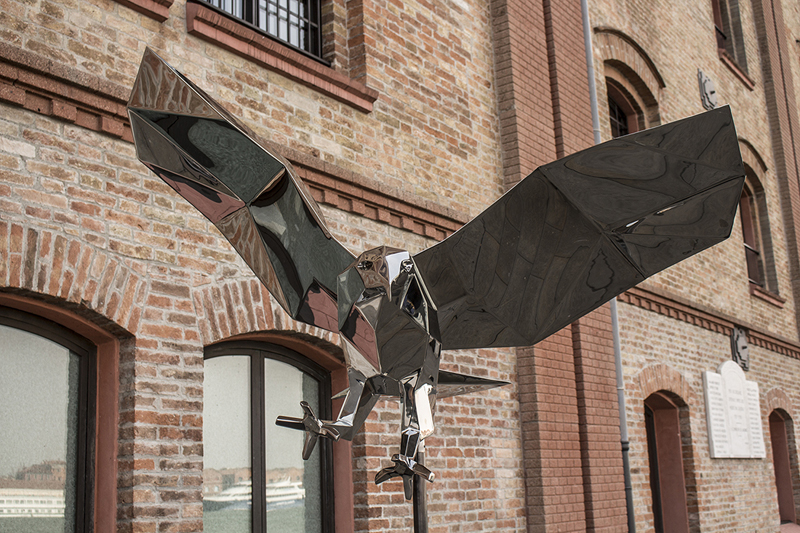
Daniele Basso
Italia • Italy
Mirror-like steel, with a sure and strong visual impact, juxtaposed to poetry and profound interior conceptuality... and the force of the material becomes an exaltation of the spirit of Basso’s works, reflecting the world that surrounds them and the ego of the spectators, who unwittingly become a part of the work itself.
Here in Achill the poet sculptor tells the life of this bird of prey of Celtic mythology which, “noble and powerful, soars lightly in the air. It possesses the sky. High above reality... a guide to love for man and his nature. It acts as a means of communication with the spiritual world and becomes a symbol of its illumination, creativity, truth and experience...’’.
Basso embraces this form of life, appreciating also its ability to view the vastness of the landscape that it looks down on, the vastness of the world and, at the same time, the ability to observe and appreciate every detail, every particular.
The subjects he depicts, like Achill here, have a dual soul, not understood as an interior and psychologically disturbed duality with respect to the outside world, but as the ability to live on its own spirituality and to exist, and wisely to adopt also the nuances of the “rest”... Sovereign Nature and the human race become joint protagonists of his artistic expressions, able to be renewed at any moment, yet maintaining their memory.
Lightly Achill soars over the environment and lands in the Lagoon as a symbol of Art’s constructive violence, able to transform the nature of the delicate Lagoon, strengthening it with force and sureness, watching over it...
Serena Mormino, Curator
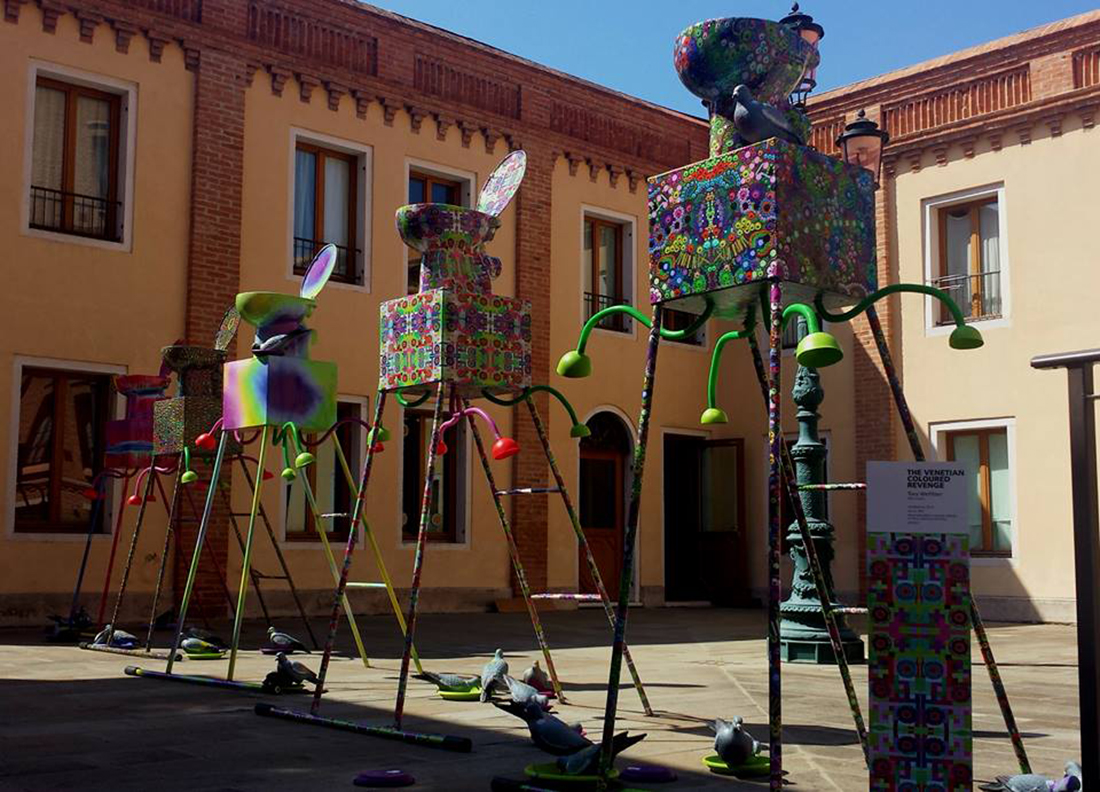
Lello Ardizzone alias Tony Wetfloor
Italia • Italy
Wetfloor’s works communicate great culture and tradition, skilfully expressed in a contemporary and technological key; but very little is known about the man himself. We know he is English, born around 1960 (we found his photo as a child on the social networks), but nothing more, only that he likes to travel for work and pleasure. Some say he does not even have a permanent address, but just a suite booked in the most fashionable hotels in capital cities, of course under a pseudonym.
Although they are heterogeneous, his works are immediately recognisable for the strength and culture that they emanate. Tibetan mandala from Vedic culture almost tattooed on the canvas, little mythological figures of warriors drowned in an interweave of colours that immediately point to street art and to a diametrically opposite culture.
Canvases that are rarely poor in colour, apart from some fine black and white work in the style of Vedova, or shaded navy blues rich in light in the style of Sturla. More often, the colours are mixed. The first works present pale shaded Pantones, rigorous brush-strokes like those of the great Dorazio.
Canvases scattered with coloured spots, with larger black ones here and there, as though for a moment your Ipad had lost its power or its connection; mosaics laid tile by tile on the tablet, with great technical precision and the knowledge of ancient and more contemporary symbolism.
Twenty-first century Persian rugs, woven and knotted by hand on the Ipad; every single detail is made, without “copy and paste”. Because nothing is “trivially” borrowed and copied from art history. Before becoming a canvas, each file is the result of graphic and mental reworking, cultures that are blended skilfully and first-person experience. But also of the emotions of the moment.
His most interesting pieces are produced in airport lounges or waiting areas, between one trip and another. And in fact the intensity of the colour changes, as well as the violence with which he throws the images down on the video of his Ipad. A tablet used like an old notebook or like a large- format canvas. A tablet without an Internet connection, because Wetfloor does not want to be traced and distracted by the social networks... perhaps because that PC from which something is extrapolated by his Art is like a sheet of paper, a blank canvas. The canvas where you must not copy, but reinterpret... What is not Art?
Serena Mormino, Curator